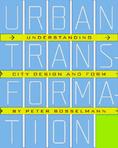smart city economics conferences heritage public spaces dottorati inu study day strategic planning mega-events regulation planning welfare city-regions open position call for papers Community maps Communication globalization urban policies safety & security adi democrazia summer schools urban design
Urban transformation
Understanding City Design and Form
Peter Bosselmann
How do cities transform over time? And why do some cities change for the better while others deteriorate? In articulating new ways of viewing urban areas and how they develop over time, Peter Bosselmann offers a stimulating guidebook for students and professionals engaged in urban design, planning, and architecture. By looking through Bosselmann’s eyes - aided by his analysis of numerous color photos and illustrations - readers will learn to “see” cities anew.
Bosselmann organizes the book around seven “activities”: comparing, observing, transforming, measuring, defining, modeling, and interpreting. He introduces readers to his way of seeing by comparing satellite-produced “maps” of the world’s twenty largest cities. With Bosselmann’s guidance, we begin to understand the key elements of urban design. Using Copenhagen, Denmark, as an example, he teaches us to observe without prejudice or bias. He demonstrates how cities transform by introducing the idea of “urban morphology” through an examination of more than a century of transformations in downtown Oakland, California.
We learn how to measure quality-of-life parameters that are often considered un-measurable, including “vitality,” “livability,” and “belonging”. Utilizing the street grids of San Francisco as examples, Bosselmann explains how to define urban spaces. Modeling, he reveals, is not so much about creating models as it is about bringing others into public, democratic discussions. Finally, we find out how to interpret essential aspects of “life and place” by evaluating aerial images of the San Francisco Bay Area taken in 1962 and those taken forty-three years later.
Bosselmann has a unique understanding of cities and how they “work.” His hope is that, with the fresh vision he offers, readers will be empowered to offer inventive new solutions to familiar urban problems.
From book's presentation
CONTENTS
List of figures
Acknowledgments
Introduction
Chapter 1.
To compare: Cities, Size, Scale and Form
Chapter 2.
To observe: Some Observations of Copenhagen's City Form
at the Time of Global Change
Chapter 3.
To measure: Vitality, Livability and Sense of Place
Chapter 4.
To transform: Rebuilding the Structure of the Inner City
Chapter 5.
To define: Urban Design Principles for City Streets
Chapter 6.
To model: Authenticity, Modeling, and Entitlement
Chapter 7.
To interpret: A Canvas for an Emerging Commons
Conclusion. Principles of Precedent
Notes
Bibliography
Index
ABOUT THE AUTHOR:
Peter Bosselmann is professor of urban design at the University of California, Berkeley. International teaching positions include universities in Europe, Australia, and Asia. He directed design workshops in China, Vietnam, Mexico, Italy, and France and was commissioned to work on urban design plans in San Francisco, New York, Toronto, and Tokyo. In 2007 he established an urban research laboratory in Milan, the fourth such laboratory that he modeled after the well-known Berkeley Environmental Simulation Laboratory. His previous publications include the 1997 book Representation of Places.




Planum
The Journal of Urbanism
ISSN 1723-0993
owned by
Istituto Nazionale di Urbanistica
published by
Planum Association
ISSN 1723-0993 | Registered at Court of Rome 4/12/2001, num. 514/2001
Web site realized by ChannelWeb & Planum Association | Powered by BEdita 3

